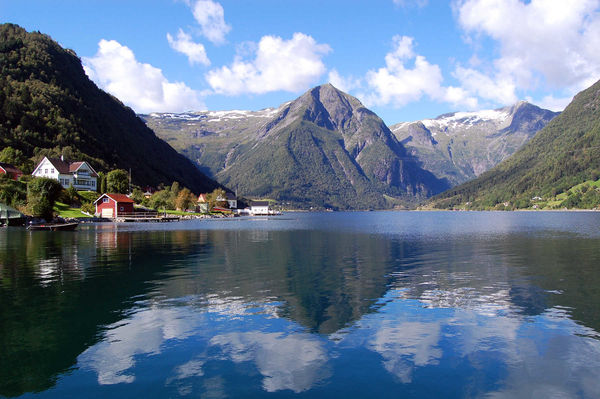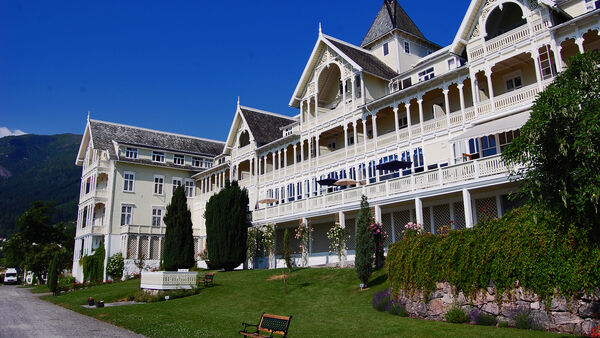Fjordside Balestrand


By Rick Steves
The pleasant fjord town of Balestrand (pop. 2,000) has a long history of hosting tourists, thanks to its landmark Kviknes Hotel. But it also feels real and lived-in, making Balestrand a nice mix of cuteness and convenience. The town is near, but not too near, the Norway in a Nutshell bustle across the fjord — and yet it's an easy express-boat trip away if you'd like to dive into the Nuttiness. In short, consider Balestrand a worthwhile detour from the typical fjord visit — allowing you to dig deeper into the Sognefjord, just like the glaciers did during the last ice age.
Most travelers arrive in Balestrand on the express boat from Bergen or Flåm. The tidy harbor area has a tourist information office, two grocery stores, a couple of galleries, a town history museum, and a small aquarium devoted to marine life found in the fjord. The historic wooden Kviknes Hotel and its ugly modern annex dominate Balestrand's waterfront.
Warning: Balestrand pretty much shuts down from mid-September through mid-May — when most of its activities, sights, hotels, and restaurants are likely closed.
But even during tourist season, Balestrand is quiet. How quiet? The police station closes on weekends. And it's tiny — from the harbor to the Balestrand Hotel is a five-minute stroll, and you can walk from the aquarium to Kviknes Hotel in less than that.
Balestrand became accessible to the wider world in 1858 when an activist minister (from the church across the fjord from town) brought in the first steamer service. That put Balestrand on the Grand Tour map of the Romantic Age. Even the German Kaiser chose to summer here. Today, people from around the world come here to feel the grandeur of the fjord country and connect with the essence of Norway.
One night is enough to get a taste of Balestrand. But with two nights you can relax and consider some day trips: Cruise up the nearby Fjærlandsfjord for a peek at a distant tongue of the ever-less-mighty Jostedal Glacier, or head across the Sognefjord to the beautiful Hopperstad Stave Church in Vik.
My top tip for your time in the town itself is to stroll the (short) length of its tiny harbor. Start at the aquarium, worth visiting for a look at marine life in the Sognefjord. Across the street, at The Viking Ship shack, a German woman named Carola sells German sausages with an evangelical zeal. A couple of doors down, the Spindelvev ("Spider's Web") shop sells handicrafts made by people with physical and mental disabilities. A local home for the disabled was closed in the 1980s, but many of its former residents stayed in Balestrand because the government gave them pensions and houses in town.
Then, in an ugly modern strip mall, you'll find the tourist information office, supermarket, and a community bulletin board with the schedule for the summer cinema (the little theater, 800 yards away, runs films nightly in their original language). On the corner is the Golden House art gallery and museum, which was built as a general store in 1928. Today it houses an art installation called "Golden Memories" and a quirky museum created by a local watercolorist and historian.
Behind it — and built into solid rock — is the boxy, new moss-covered home of the Norwegian Travel Museum (Norsk Reiselivsmuseum), featuring photos showing this part of Norway over the past 150 years, interactive exhibits, and souvenirs. And just beyond that is the dock where the big Bergen–Sognefjord express catamaran ties up.
Across the street is a cute white house that used to stand at the harborfront until the big Joker supermarket and Kviknes Hotel, with its modern annex, partnered to ruin the town center. This little house was considered historic enough to be airlifted 100 yards to this new spot. It's flanked by two other historic buildings, which house a gallery and an artisans' workshop.
Farther along is a rust-red building that was the waiting room for the 19th-century steamer that first brought tourism to town. After a few more steps comes the tall stone monument erected to celebrate the North Bergen Steamship Company. Its boats first connected Balestrand to the rest of the world in 1858. In front of the monument, some nondescript concrete steps lead into the water. These are "The Kaiser's Stairs," built for the German emperor, Kaiser Wilhelm II, who made his first summer visit (complete with navy convoy) in 1899 and kept returning until the outbreak of World War I.
Behind the monument stands one of the largest old wooden buildings in Norway, Kviknes Hotel. It was built in the 1870s and faces the rare little island in the fjord, which helped give the town its name: "Balestrand" means the strand or promenade in front of an island. (The island is now connected to the hotel's front yard and is part of a playground for its guests.) Inside, its plush old lounge is a virtual painting gallery. All the pieces are by artists from this area, celebrating the natural wonder of the fjord country — part of the trend that helped 19th-century Norway reconnect with its heritage.
From here it's a short walk along King Bele's Way — the "old road" from the harbor — along the fjord's edge to St. Olaf's Church. Construction on this distinctive wooden church, built in 1897, was started by Margaret Sophia Kvikne, the wife of Knut Kvikne (of the Kviknes Hotel family) — but she died in 1894, before the church was finished. This devout Englishwoman wanted a church in Balestrand where English services were held...and to this day, bells ring to announce services by British clergy.
St. Olaf, who brought Christianity to Norway in the 11th century, was the country's patron saint in Catholic times. The church was built in a "Neo-stave" style, with lots of light from its windows and an altar painting inspired by the famous Risen Christ statue in Copenhagen's Cathedral of Our Lady. Here, Christ is flanked by fields of daisies (called "priests' collars" in Norwegian) and peace lilies. From the door of the church, enjoy a good view of the island in the fjord.
Balestrand also has outdoor activities for everyone, from dreamy fjordside strolls and strenuous mountain hikes to wildly scenic bike rides. For dinner, splurge on the memorable smörgåsbord-style store koldt bord dinner in the Kviknes Hotel dining room, then sip coffee from its balcony as you watch the sun set (or not) over the fjord.

